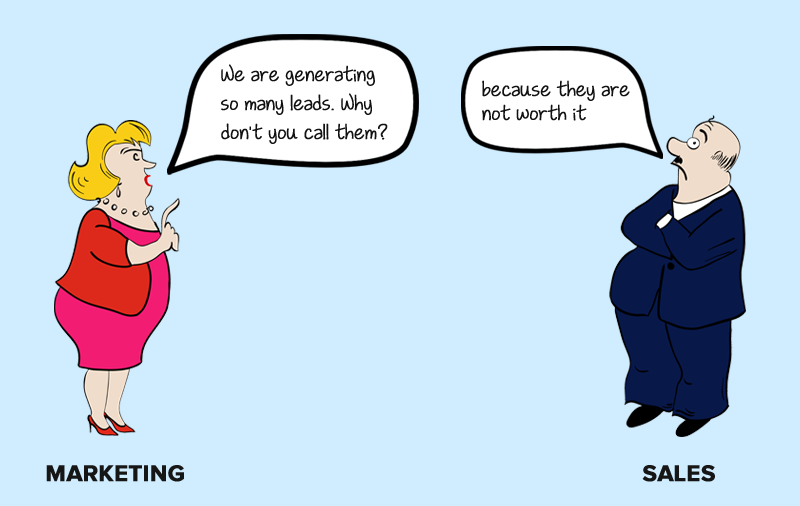 Does this ever happen between your sales and marketing teams?
Does this ever happen between your sales and marketing teams?
Marketers spend a lot of time, effort and money to create compelling campaigns, optimize them to generate leads, set auto-responders and alerts to connect with them promptly, before finally delivering the leads to the sales team. Many sales people do not even know these terms, but they very well know their targets and when they don’t meet them, they often complain about the quality of leads. The leads never seem to close and most of the times, the argument is – the leads were not good.
Marketing team either doesn’t like it or they don’t care. They are busy running ads and writing content to attract, capture and engage leads, more leads. Leads are everything. That’s what bridges marketing and sales after all. There’s a gaping hole in this bridge though. It makes the sales team complain about lead quality and marketing team annoyed with missed follow-ups for their hard earned leads. That hole is the absence of lead qualification, which if filled can ensure better alliance between the two powerhouses of your business – sales and marketing.
Lead Qualification : A lesson finally learnt
Lead Qualification is the process where the leads are checked to identify if they are really interested in your business or not, before being forwarded to the sales team. These qualified leads are also called sales ready leads.
At LeadSquared, we generate thousands of leads per month, from all sources combined. There leads can broadly be categorized in these four categories :
- Invalid – wrong email id, phone number
- Not interested – no requirement
- Partly Interested – the maybe(s)
- Interested – ready to buy
Not very long ago, the leads were assigned to pre-sales team for qualification and initial conversation. Once qualified, they were forwarded to sales. The “not interested” leads were given back to marketing for nurturing and invalid leads were dumped. The customer acquisition cycle looked something like this :
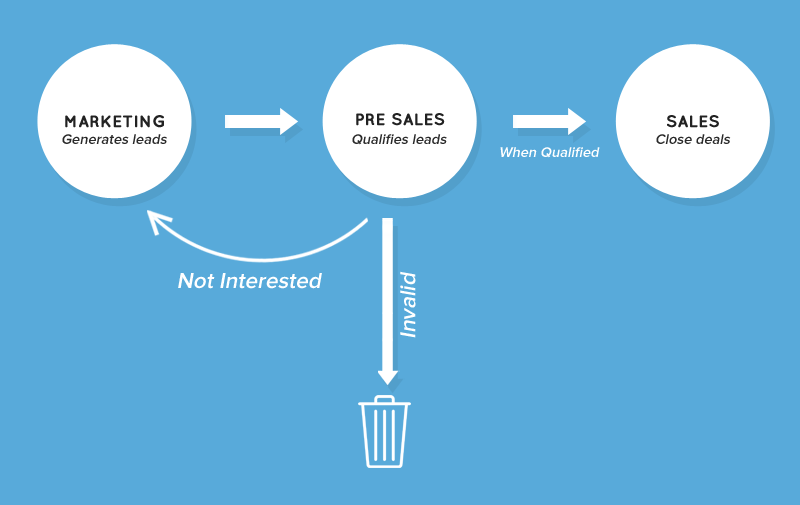 The pre-sales team focused qualifying new leads and following up with the older ones, which caused two major concerns :
The pre-sales team focused qualifying new leads and following up with the older ones, which caused two major concerns :
Pre-Sales bandwidth – Around one-third of all the new leads fell into Invalid/not interested category. Pre-sales team contacting them for qualification required a lot of time and effort.
Less time for outbound efforts – There was very little/no time left for outbound. Outbound lead generation presents a key revenue opportunity, which we were missing on.
In 2016-mid, we reinvented our process by introducing a lead quality check between pre-sales and sales. The process translated to something like this:
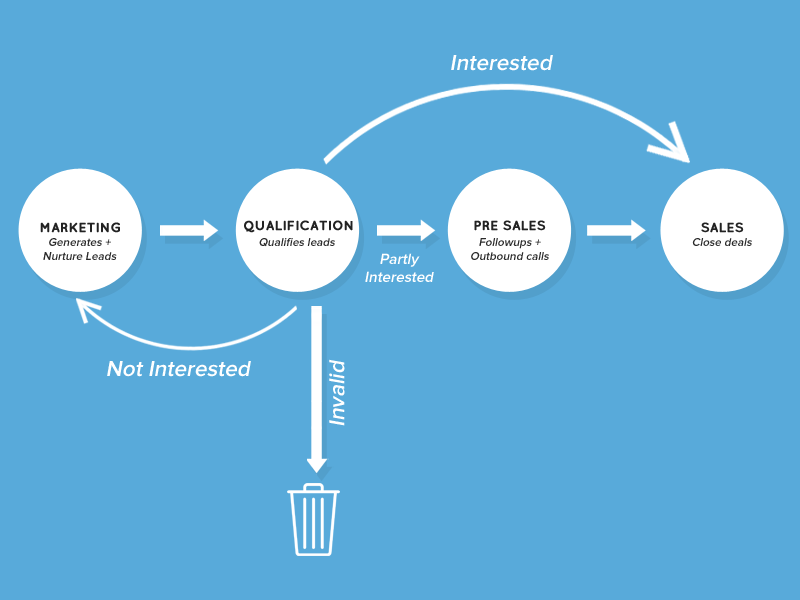
- Invalid leads were directly dumped by the Lead Qualification team
- Not interested leads were given back to the marketing team for nurturing
- Partly interested leads were given to the pre-sales team
- Interested leads were directly given to the sales team
This change was happily accepted by all the teams because everyone had more clarity on what exactly they needed to do. We found that it eventually had a positive impact on the revenue because of:
1. More time for outbound lead generation
Pre-Sales team now had more time to focus on outbound calls. In a business like ours, we can’t ignore it. The ticket size in outbound was more and they did not need a qualification, unlike the inbound leads.
2. Better allocation of resources
Every one has a different skill set. The skill of lead qualification team is to pass and fail the lead quickly, sometimes based on instincts. However the art of the pre-sales representative is to communicate. That’s what they do best. Adding a qualification layer ensured better allocation of resources.
3. Better followups
With the introduction of the lead qualification team, the new leads were quickly checked (accepted or rejected) which meant the most serious leads went to sales team faster. On the other hand the pre-sales team could spend more time on the old leads to make them sales ready.
Marketing team’s role in lead qualification
Although lead generation and lead management strategies change with every industry and business type – B2C or B2B, nobody wants junk leads. Some level of lead qualification should always be implemented, even for B2C businesses, whether you are buying a list or running ads. It is not just the lead qualification team’s responsibility to filter out the unwanted. Marketing team can also contribute to lead qualification by :
1. Right targeting
If your marketing team is targeting the wrong audience, no matter how hard your qualification or pre-sales teams work, it just won’t cut it. The lead qualification team should help marketers understand which kind of leads are turning into deals, which industries are they from? What are their demographics? This information is a goldmine for marketers because it helps them:
- Run ads on the most relevant keywords or concepts
- Write right content to engage that kind of audience
- Create help resources for that very persona
This is only possible if there is constant feedback from qualification team to marketing team. But, you have to remember, if the targeting is tight, the lead volume goes down. Marketing team should never be afraid of that. The correct metric to measure the marketing’s lead generation success should be qualified leads, not just the number of leads. Check out this very entertaining adwords post which explains this further.
2. Tightening the lead generation process
Form design – In my last post, I emphasized on reducing the number of form fields to increase conversions. I’ll contradict myself today – keep as many fields as possible to qualify leads right at the onset. Don’t get me wrong; I still stick by the idea that you shouldn’t put unnecessary fields on the form, but don’t remove the important, qualifying fields only to increase conversions. As discussed above, generating more leads isn’t necessarily the best thing. Maintain a delicate balance between too many (too difficult to annoy) and too less (too easy to fill just like that).
Email/ Phone validators – These validators will check the authenticity of the phone numbers or email address and will not let the visitor fill up the form with incorrect entries. This the first sign of a possibly junk lead. Have validators in your form to get rid of the spammy submissions.
Ask what they want – At the time of submitting the form, you should always ask your leads what they are looking for and what they perceive from your ad? One, this information is really useful in predicting the quality of the lead. Two, it helps you tweak your ad in a way that visitors will understand. Check out the landing page that appears when someone signs up for a LeadSquared’s free trial.
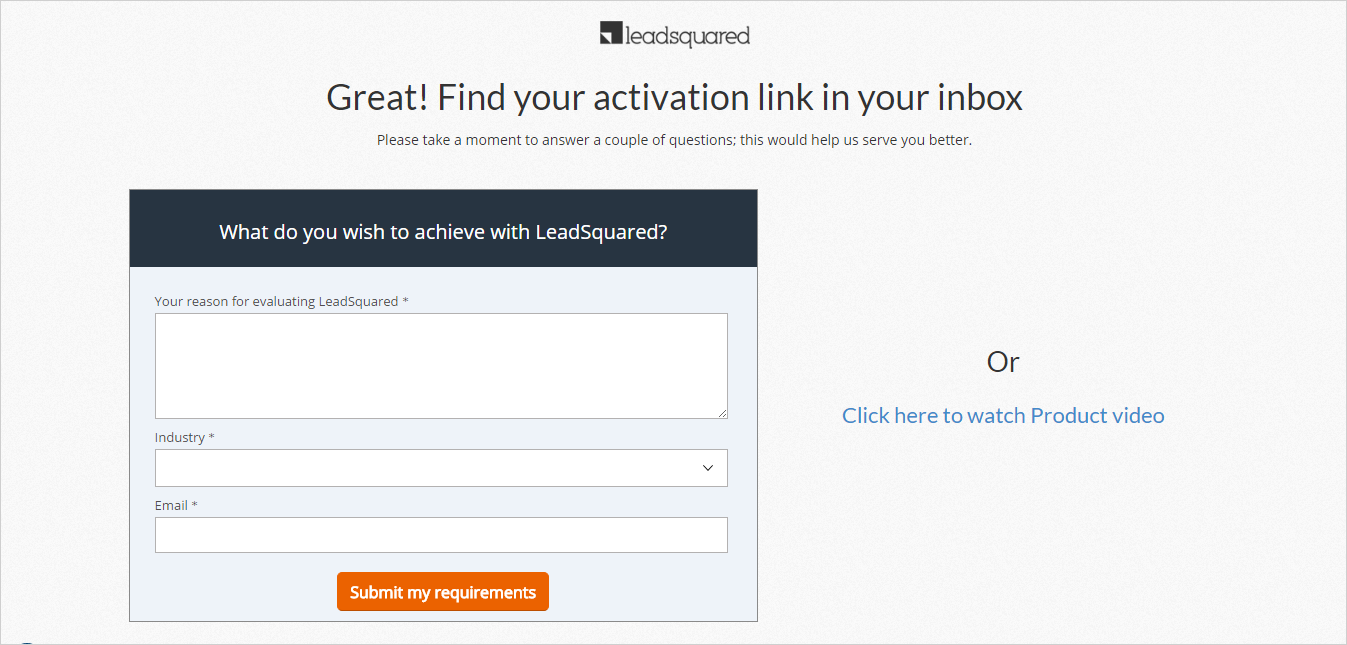 Surprisingly, this page’s conversion rate is 70% which is pretty good. If you ask, you’ll get a response. These responses help marketing and sales teams understand the requirements of the lead, and helps the qualification team check the seriousness of the buyer.
Surprisingly, this page’s conversion rate is 70% which is pretty good. If you ask, you’ll get a response. These responses help marketing and sales teams understand the requirements of the lead, and helps the qualification team check the seriousness of the buyer.
3. Using a lead management system
Some CRM and Lead Management systems like LeadSquared give a score to each lead based on the chances of their closure. This scoring is called Quality Scoring. Quality score can be set by the business on the basis of their ideal buyer persona. Let’s take an example :
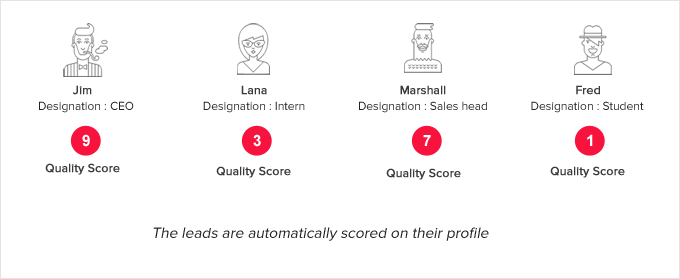 Quality score makes it evident that Jim needs to be chased first. This helps the lead qualification team prioritize their tasks and reach out to the most serious lead first. Although quality and lead scoring helps a user understand the seriousness and the intent of the buyer to some extent, it can never fully replace the human interaction. That being said, it saves a lot of time and energy if set properly.
Quality score makes it evident that Jim needs to be chased first. This helps the lead qualification team prioritize their tasks and reach out to the most serious lead first. Although quality and lead scoring helps a user understand the seriousness and the intent of the buyer to some extent, it can never fully replace the human interaction. That being said, it saves a lot of time and energy if set properly.
In the end
Sales and marketing are very different from each other but they strive for a common goal – generating more revenue. A lead qualification process will help sales by giving them more time for followups and outbound calls, and will help marketing with data driven feedback to tweak their campaigns accordingly, hence bridging the gap between the two.
What do you think? How are your currently qualifying your leads? Let’s talk in comments.










